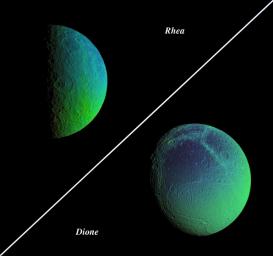Saturn's cratered, icy moons, Rhea and Dione, come alive with vibrant color that reveals new information about their surface properties.
To create these false-color views, ultraviolet, green and infrared images were combined into a single black and white picture that isolates and maps regional color differences. This "color map" was then superimposed over a clear-filter image of each moon.
The combination of color map and brightness image shows how the colors vary across the moon's surface in relation to geologic features. The origin of the color differences is not yet understood, but may be caused by subtle differences in the surface composition or the sizes of grains making up the icy soil.
The Rhea view is a two-image mosaic. Images in the mosaic were acquired on Aug. 1, 2005, at a mean distance of 214,700 kilometers (133,400 miles) from Rhea and at a Sun-Rhea-spacecraft, or phase, angle of 88 degrees. Image scale is 1.3 kilometers (0.8 miles) per pixel.
The mosaic shows terrain on the trailing hemisphere of Rhea (1,528 kilometers, or 949 miles across), and is centered on 42 degrees south latitude. North is up and rotated 28 degrees to the left.
Images in the Dione false-color view were acquired on Aug. 1, 2005, at a mean distance of 267,600 kilometers (166,300 miles) from Dione. Image scale is 1.6 kilometers (1 mile) per pixel.
The image shows terrain on the trailing hemisphere of Dione (1,126 kilometers, or 700 miles across), and is centered on 41 degrees south latitude. North is up.
The images have not been scaled to show the moons' proper relative sizes.
The Cassini-Huygens mission is a cooperative project of NASA, the European Space Agency and the Italian Space Agency. The Jet Propulsion Laboratory, a division of the California Institute of Technology in Pasadena, manages the mission for NASA's Science Mission Directorate, Washington, D.C. The Cassini orbiter and its two onboard cameras were designed, developed and assembled at JPL. The imaging operations center is based at the Space Science Institute in Boulder, Colo.
For more information about the Cassini-Huygens mission visit http://saturn.jpl.nasa.gov. The Cassini imaging team homepage is at http://ciclops.org.

 Planetary Data System
Planetary Data System












